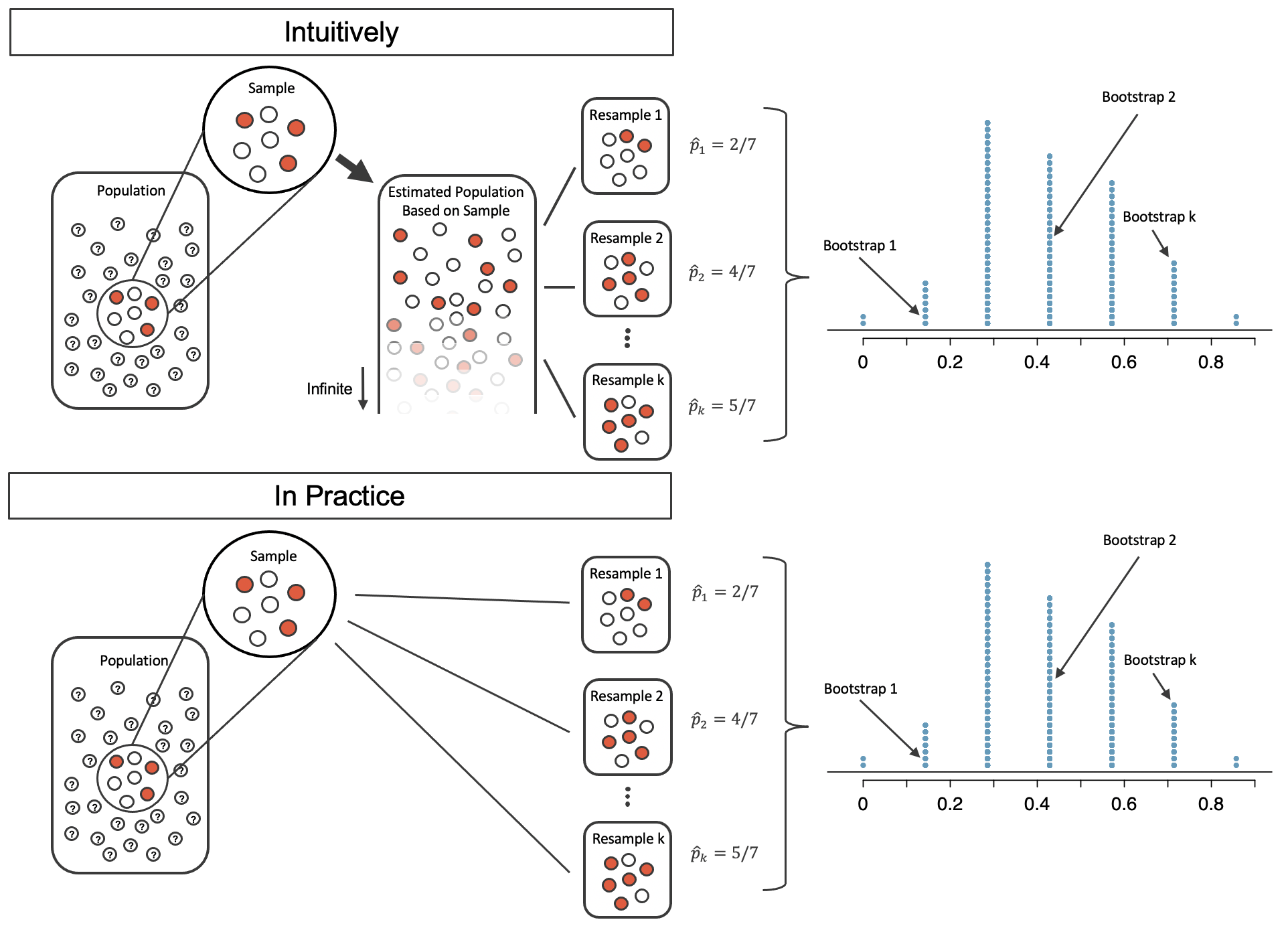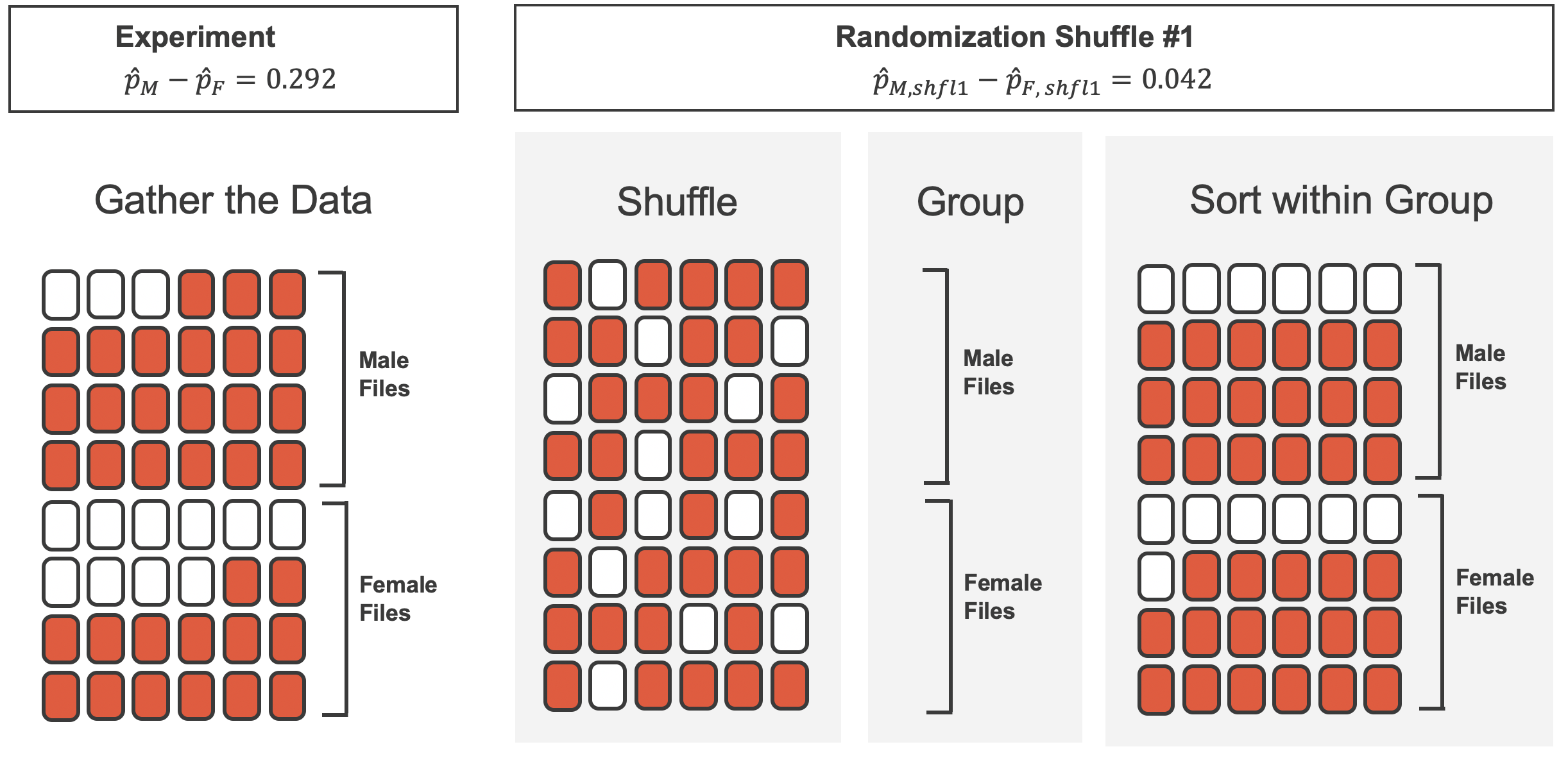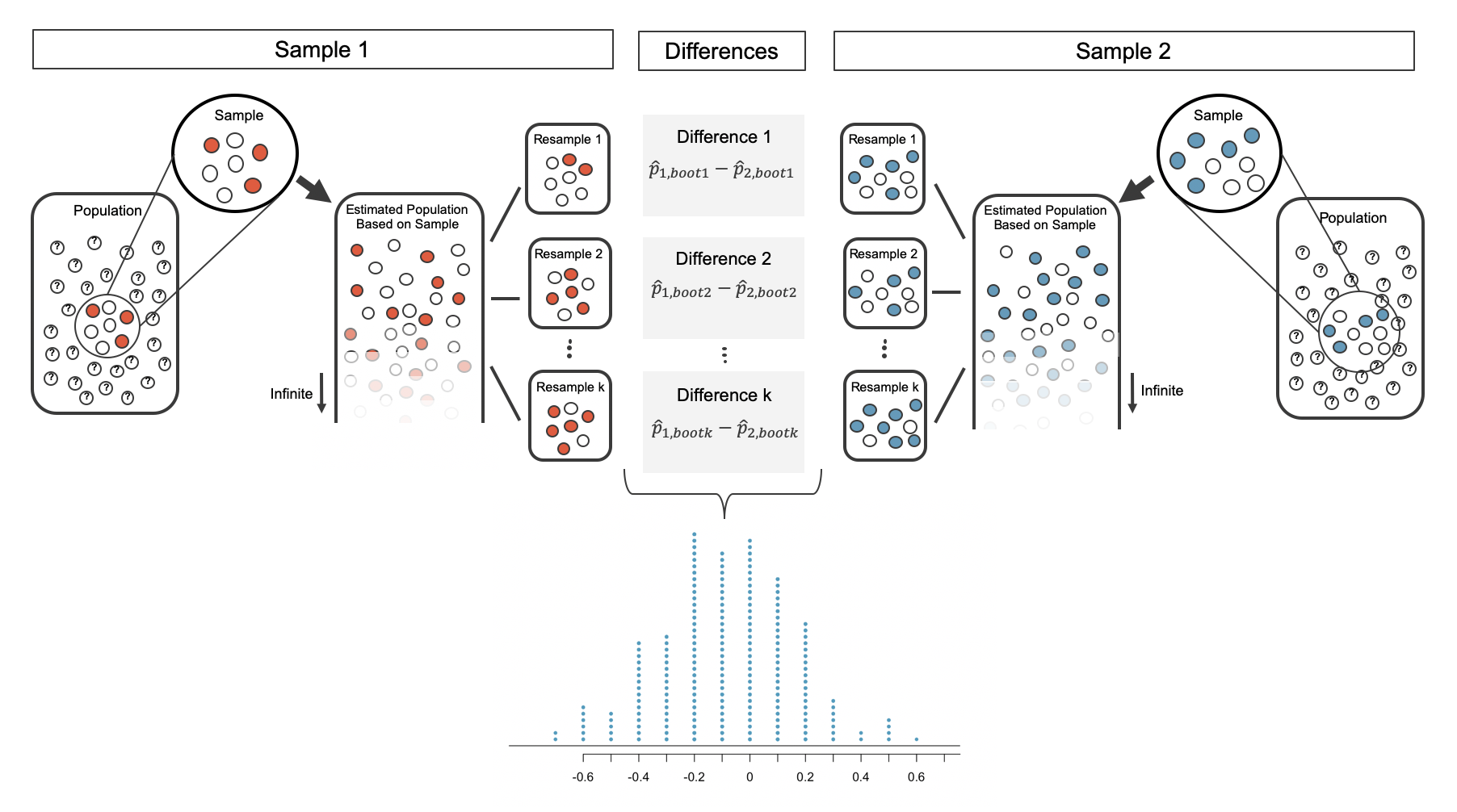01:00
Inference for proportions
STA 101L - Summer I 2022
Raphael Morsomme
Welcome
Announcements
- Data analysis in action – Inferring ethnicity from X-rays
- Anonymous mid-course feedback
Recap
Statistical inference
Five cases
Hypothesis test
Confidence interval
A first glimpse of modern statistics
Outline
- One proportion (case 1)
- Two proportions (case 2)
One proportion
Setup
population parameter: proportion \(p\)
Sample statistics: sample proportion \(\hat{p}\)
Hypothesis testing:
\(H_0:p=p_0\) where \(p_0\) is a number between \(0\) and \(1\)
\(H_a:p\neq p_0\)
Confidence interval: range of plausible values for \(p\).
One-sided and two-sided \(H_a\)
One-sided) \(H_a:p>p_0\) or \(H_a:p<p_0\)
Two-sided) \(H_a: p\neq p_0\)
It is never wrong to use a two-sided \(H_a\).
Individual exercise - Hypotheses
Exercise 16.1
Example – legalizing marijuana
What proportion of US adults support legalizing marijuana?
Sample: 900/1500 support it.
\[ \hat{p} = \dfrac{900}{1500}=0.6 \]
Hypothesis test via simulation
\(H_0:p=0.5\)
\(H_a:p\neq 0.5\)
Simulate many samples under \(H_0\).
Determine if the observed data could have plausibly arisen under \(H_0\).
Parametric bootstrap
The textbook uses the term (parametric) bootstrap to refer to this procedure.

Conclusion
\(\hat{p}=0.6\) is extremely unlikely to happen under \(H_0:p=0.5\).
We therefore reject the null hypothesis that half of the people support legalizing marijuana.
Group exercise - HT for one proportion
Exercise 16.3 – in part d, you do not need to estimate the p-value.
03:00
p-value
What if we do not have a clear-cut case?
- e.g., \(\hat{p}=0.52 = \dfrac{780}{1500}\)
p-value: probability that the sample statistic of a sample simulated under \(H_0\) is at least as extreme as that of the observed sample.
- the probability that \(\hat{p}_{sim} > 0.52\) or \(\hat{p}_{sim} < 0.48\).
p-value in R
# A tibble: 10,000 x 2
p_hat is_more_extreme
<dbl> <lgl>
1 0.475 TRUE
2 0.485 FALSE
3 0.483 FALSE
4 0.528 TRUE
5 0.51 FALSE
6 0.493 FALSE
7 0.503 FALSE
8 0.5 FALSE
9 0.495 FALSE
10 0.503 FALSE
# ... with 9,990 more rowsp-value in practice
In practice, if a p-value is smaller than 0.05 we reject \(H_0\)
\(\alpha = 0.05\) is called the significance level.
If \(p<0.05\), the observed sample is in the top 5% of the most extreme simulated samples.
It is highly unlikely that the observed sample could have arisen if \(H_0\) were true.
the difference \(\hat{p}-p_0\) is statistically significant.
Why \(\alpha = 0.05\)?
To know why the significance level 0.05 is widely used in practice, check out this short video.
Group exercise - HT for one proportion
Exercise 16.5.
04:00
Confidence interval via bootstrap
Bootstrapping
Sample with repetition from the observed sample to construct many bootstrap samples.
Bootstrap samples \(\Rightarrow\) sampling distribution \(\Rightarrow\) CI

Source: IMS
Bootstrap in R
# A tibble: 5 x 1
support
<dbl>
1 0
2 0
3 1
4 1
5 0
03:30
Two proportions
Setup
A population divided in two groups.
Population parameter: difference in proportion
\[ p_{diff}=p_1-p_2 \]
Sample statistics: difference in proportion in the sample
\[ \hat{p}_{diff}=\hat{p}_1-\hat{p}_2 \]
\(H_0:p_{diff}=0\) (no difference between the two groups)
\(H_a:p_{diff}\neq0\)
Example – sex discrimination
Are individuals who identify as female discriminated against in promotion decisions?
decision |
|||
|---|---|---|---|
| sex | promoted | not promoted | Total |
| male | 21 | 3 | 24 |
| female | 14 | 10 | 24 |
| Total | 35 | 13 | 48 |
Group exercise - two proportions
What are \(\hat{p}_f\), \(\hat{p}_m\) and \(\hat{p}_{diff}\)? Do you intuitively feel that the data provide convincing evidence of sex discrimination?
02:00
Hypothesis test via simulation
\(H_0:p_{diff}=0\)
\(H_a:p_{diff}\neq 0\)
Simulate many samples under \(H_0\) (no discrimination)
Determine if the observed data could have plausibly arisen under \(H_0\)
Simulating under \(H_0\)
Under \(H_0\), there is no discrimination
\(\Rightarrow\) whether someone receives a promotion is independent of their sexual identification,
\(\Rightarrow\) randomly re-assign the \(35\) promotions independently of the sexual identification.
 Source: IMS
Source: IMS
Simulation result
decision |
|||
|---|---|---|---|
| sex | promoted | not promoted | Total |
| male | 18 | 6 | 24 |
| female | 17 | 7 | 24 |
| Total | 35 | 13 | 48 |
Source: IMS
d <- gender_discrimination
d_sim <- d %>% mutate(decision = sample(decision)) # shuffle the promotions
d_sim# A tibble: 48 x 2
gender decision
<fct> <fct>
1 male not promoted
2 male not promoted
3 male promoted
4 male promoted
5 male promoted
6 male promoted
7 male promoted
8 male not promoted
9 male promoted
10 male not promoted
# ... with 38 more rowsFunction for computing the test statistic
For-loop for simulating under \(H_0\)
# Setup
results <- tibble(p_diff_hat = numeric())
d <- gender_discrimination
# Simulations
set.seed(0)
for(i in 1 : 1e4){
d_sim <- d %>% mutate(decision = sample(decision)) # simulate under H0
p_diff_hat <- compute_p_diff(d_sim) # test statistic
results <- results %>% add_row(p_diff_hat = p_diff_hat)
}Sampling distribution
[1] 0.2916667
p-value
p-value: probability that the sample statistic of a sample simulated under \(H_0\) is at least as extreme as that of the observed sample.
- the probability that \(\hat{p}_{diff}^{sim}\ge\) 0.29 or \(\hat{p}_{diff}^{sim}\le\) -0.29.
significance level \(\alpha = 0.05\)
Using the usual significance level \(\alpha = 0.05\), we reject the null hypothesis
- the observed difference in promotions is unlikely to be due to random luck
- the difference is statistically significant.
Statisticians as messengers
Statisticians are just messengers; they only interpret what the data are indicating.
If you are a scientist and are not happy with the result of a statistical analysis, change the study not the statistician!
- larger sample
- smaller measurement errors
- new variables, e.g. salary instead of promotion
Group exercise - HT
17.1 (skip part b)
03:00
Confidence interval via bootstrap
Same idea as before: sample with repetition from the observed data to construct many bootstrap samples.
Bootstrap samples \(\Rightarrow\) sampling distribution \(\Rightarrow\) CI
Bootstrap

Source: IMS
Bootstrap in R
sample_observed_m <- gender_discrimination %>% filter(gender == "male" )
sample_observed_f <- gender_discrimination %>% filter(gender == "female")
set.seed(0)
sample_bootstrap(sample_observed_m) # bootstrap sample# A tibble: 24 x 2
gender decision
<fct> <fct>
1 male promoted
2 male promoted
3 male promoted
4 male promoted
5 male promoted
6 male not promoted
7 male promoted
8 male promoted
9 male promoted
10 male promoted
# ... with 14 more rows# A tibble: 24 x 2
gender decision
<fct> <fct>
1 female promoted
2 female promoted
3 female promoted
4 female promoted
5 female promoted
6 female not promoted
7 female promoted
8 female not promoted
9 female promoted
10 female promoted
# ... with 14 more rowsresults <- tibble(p_diff_hat = numeric())
for(i in 1 : 1e4){
d_boot_m <- sample_bootstrap(sample_observed_m) # bootstrap sample
d_boot_f <- sample_bootstrap(sample_observed_f) # bootstrap sample
p_diff_hat <- compute_p_diff(rbind(d_boot_m, d_boot_f)) # bootstrap statistic
results <- results %>% add_row(p_diff_hat = p_diff_hat)
}
Two sides of the same coin
In the two examples, the HT and the CI agree with one another. This is not a coincidence; they will agree in the vast majority of cases!
We can show mathematically that a HT and a CI are really two sides of the same coin.
What does 90% and 95% mean?
Remember that if we could obtain multiple samples, they’d all be a bit different.
\(\Rightarrow\) the corresponding CIs would also be a bit different
A 90% CI will capture the true value of the parameter 90% of the time.
A 95% CI will be wider and thus more likely to capture the truth (95% of the time).
- Trade off between being informative and true.

Source: IMS
03:00
Recap
Recap
One proportion
HT via simulation
CI via bootstrap
Two proportions
HT via simulation
CI via bootstrap
